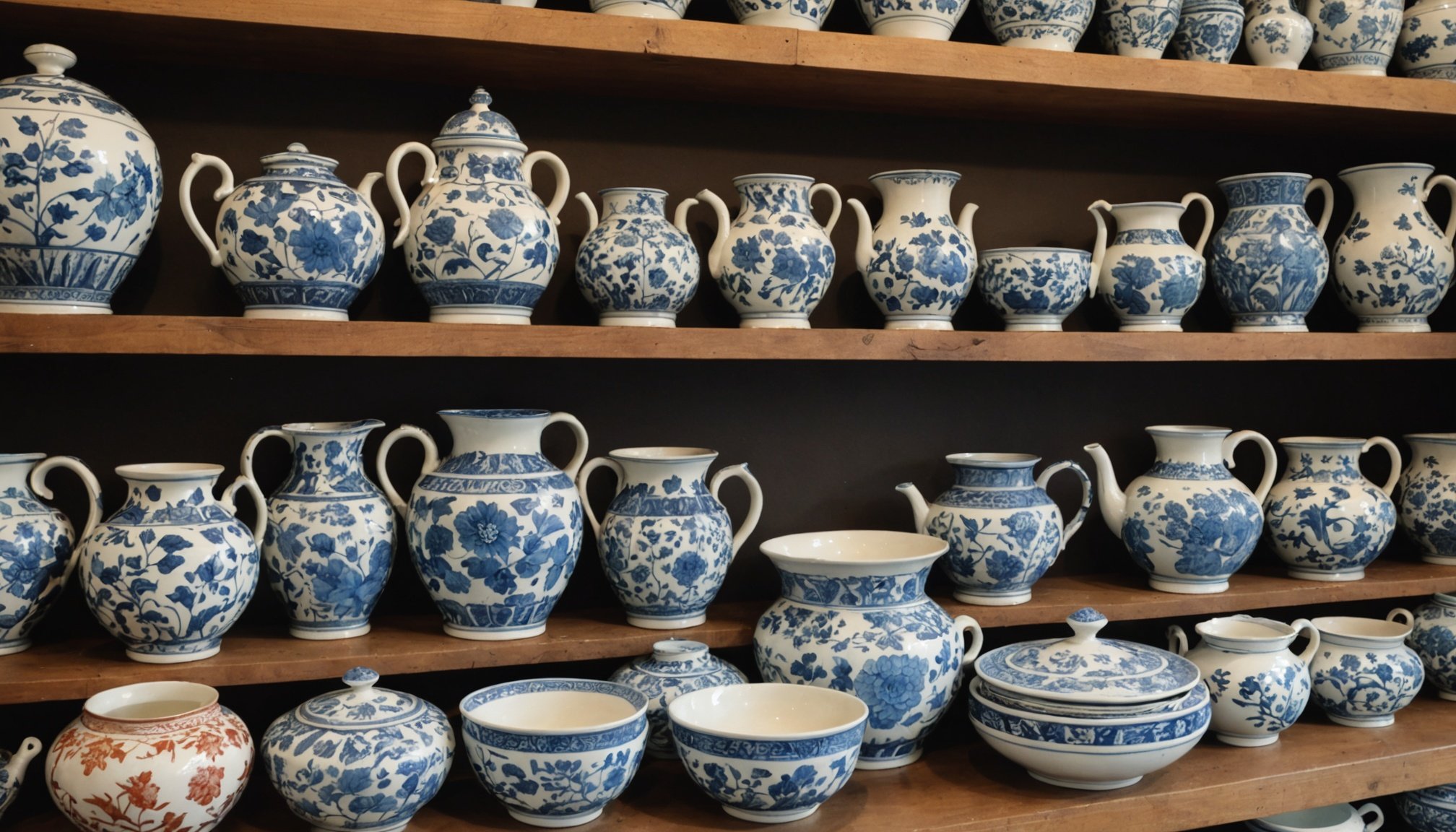Overview of British Ceramics
The history of British ceramics is a fascinating journey through time, showcasing artistic evolution and cultural significance. Ceramics in Britain date back to prehistoric times, with artifacts revealing early craftsmanship skills and daily uses. As centuries progressed, ceramics evolved from simple, utilitarian objects to highly decorative art forms.
In the medieval period, British pottery was largely influenced by imported wares and techniques from Europe, notably from Italy and Holland. However, by the 18th century, British ceramics witnessed a revolutionary phase with the emergence of the famous Staffordshire potteries. This period marked the beginning of mass production and saw innovations like transfer printing and sophisticated glazing techniques, helping ceramics become more accessible and diverse.
In the same genre : Unveiling the Rich Tales: The Most Legendary Historic Pubs in the UK
Ceramics hold a substantial cultural significance in Britain. They are revered not merely as functional items, but as symbols of artistic expression and social status. Teapots, plates, and figurines from various periods provide insight into changing tastes, economic conditions, and technological advancements.
Some notable periods in British ceramics history include the Art Deco era, known for its bold patterns and vibrant colors, and the Arts and Crafts movement, which emphasized handcrafted quality and traditional skills. British ceramics continue to be cherished worldwide, reflecting a rich tapestry of heritage and creativity.
Topic to read : Discover Authentic British Blacksmithing Workshops: Your Guide to Hands-On Traditions!
Key Regions of British Ceramics
The cultural landscape of British ceramics is deeply marked by its ceramics regions, showcasing a rich history that spans centuries. Among the most renowned is Stoke-on-Trent, often hailed as the “World Capital of Ceramics.” This city, with its quintessential pottery towns, has profoundly influenced the development of ceramic artistry.
Stoke-on-Trent, strategically nestled in Staffordshire, is celebrated for its unique local materials, such as fine clay, which have been integral to its distinct ceramic patterns and styles. The abundance of quality raw materials in these regions has fueled innovation and craftsmanship, making them pivotal in the industry.
Several pottery towns within these ceramics regions have embraced traditional techniques, handed down through generations. These methods, combined with local materials, create ceramics that are both functional and aesthetically pleasing.
Other prominent regions contributing to this rich tapestry include Devon and Cornwall, known for their beautiful pottery. Each area offers its own cultural blend of techniques and styles. This diversity provides a fascinating insight into how location influences the crafting process. As you explore the pottery towns, you’ll discover the enduring significance of local traditions in shaping the enchanting world of British ceramics.
Notable Museums and Studios
Exploring ceramics museums and visiting art galleries can provide captivating insight into both traditional and contemporary styles of the craft. From established institutions to intimate studios, each location offers a unique storytelling experience in ceramics.
Highlighting Major Museums
- National Ceramic Museum Insights: The National Ceramic Museum stands as a testament to the historical significance and evolving artistry of ceramics. It hosts an array of artifacts and contemporary pieces that depict the craft’s diverse cultures and time periods.
- V&A Museum’s Ceramics Collection: The Victoria and Albert Museum, renowned for its vast and varied collection, includes an impressive array of ceramics, showcasing creativity and craftsmanship from around the globe. Each piece in their vast collection is a story waiting to be discovered.
- Mission of the Wedgwood Museum: Dedicated to preserving the legacy of Josiah Wedgwood, the Wedgwood Museum emphasizes innovation in ceramics. Its mission revolves around educating visitors on the historical and artistic importance of the brand through meticulously curated exhibits.
Exploring Craft Studios
- Overview of renowned ceramic artists and studios: Visiting studios affords an unparalleled glimpse into the creative process. Engaging directly with artists illuminates the intricacies of their techniques and inspirations.
- Importance of visiting working studios: These visits grant a deeper appreciation for the craftsmanship and dedication involved in creating each piece, offering a tangible connection between artist and observer.
- Unique experiences offered at local studios: From hands-on workshops to collaborative art projects, local studios provide immersive experiences that highlight the dynamic nature of ceramics.
Planning Your Guided Tour
When it comes to tour planning with a focus on ceramics, a well-crafted itinerary is essential. Incorporating stops at renowned pottery villages and workshops can make for a comprehensive exploration. Ensure to include time for museum visits, where rich collections highlight the craftsmanship and history of ceramics, and don’t overlook opportunities for hands-on workshops to truly immerse yourself in the art.
Booking tips for guided tours are paramount to ensure a smooth experience. It’s advisable to book through reputable agencies that are familiar with local culture and language. They often provide experienced guides who can enhance your understanding of the ceramics scene. Early bookings can also secure better rates and offer more itinerary-building options.
When considering accommodations, prioritize hotels or guesthouses near key areas of interest to minimize travel times. For dining, local eateries and restaurants specializing in regional cuisine can provide authentic culinary experiences that complement your tour. Checking reviews online, especially through forums or group recommendations, can yield trustworthy suggestions. Through careful planning, your tour will be an enriching journey, seamlessly blending exploration with cultural insight.
Engaging Experiences Related to Ceramics
Engaging in ceramic workshops offers a unique opportunity for hands-on experiences that immerse art enthusiasts in the creative process. These workshops not only provide practical skills but also foster a deep appreciation for the craft. Participants can expect to learn techniques ranging from throwing clay on a potter’s wheel to intricate hand-building methods. These sessions are ideal for both beginners and advanced artists who wish to refine their skills and create bespoke pieces.
Beyond workshops, vibrant local events and festivals celebrate the rich tradition of ceramics. These gatherings highlight the cultural significance and creative diversity of ceramics, often featuring local artisans who showcase their handmade wares. Attendees can witness live demonstrations, engage in interactive discussions, and even participate in communal projects that amplify the communal spirit of these events.
Opportunities to purchase unique ceramics abound at these festivals, providing visitors with a chance to own one-of-a-kind pieces directly from skilled artisans. These items, ranging from functional pottery to decorative art, capture the essence of the makers’ creativity and craftsmanship. Embracing these local experiences not only supports the artisans but also enriches one’s personal connection to the world of ceramics.
Insights from Experts in British Ceramics
The world of British ceramics thrives on a foundation of artisan expertise and a passion for preserving cultural heritage. Interviews with prominent ceramic artists highlight their dedication to traditional techniques, coupled with innovative approaches. These expert opinions shed light on the evolving role of ceramics in contemporary art.
Prominent artisans emphasise the significance of traditional methods, echoing the need to maintain these practices for future generations. They often share experiences of balancing time-honoured techniques with modern influences, illustrating the dynamic nature of ceramics today. For example, a renowned potter might merge the techniques learned from masters with new, experimental glazes to create pieces both historical and modern.
Education in ceramics plays a vital role in sustaining this cultural legacy. Experts often participate in workshops and courses to share their knowledge. They underscore the importance of teaching both the craft and its history. Such educational initiatives not only preserve the past but also inspire innovation within the medium.
By providing a platform for these artisans, workshops introduce new learners to the craft, ensuring the continued vibrancy of British ceramics. The interplay between expert insights and education enriches our understanding and appreciation of ceramics as a living art form.











